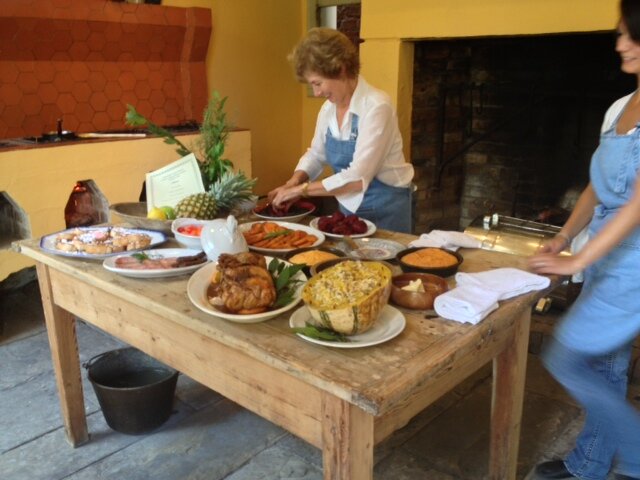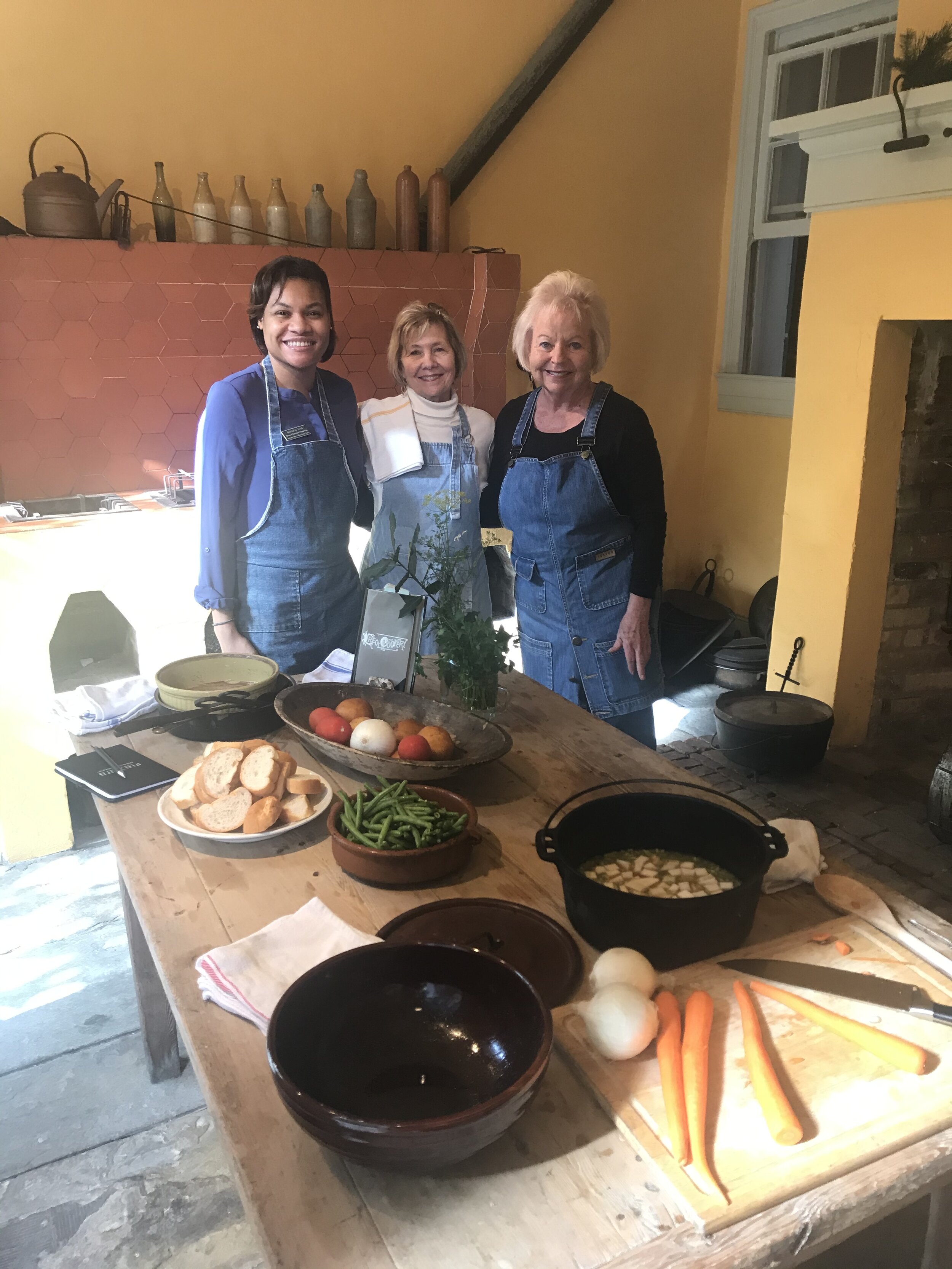The Books and Cooks of Nineteenth-Century Creole Cuisine
By Susie Trenka
The cooking demonstrations in the restored nineteenth-century kitchen at Hermann-Grima House have long been among our museum’s main attractions. Since the inaugural cooking program in 1978, volunteers have recreated countless historic recipes in the open-hearth kitchen. Many of these recipes have come from The Creole Cookery Book, first published in 1885 by the Christian Woman’s Exchange. This book is generally considered to be the first New Orleans cookbook, along with writer and newspaper editor Lafcadio Hearn’s La Cuisine Créole, which was published anonymously the same year. Despite its French title, Hearn’s book, too, was written in English.
There is some evidence of the use of French cookbooks in New Orleans in the late eighteenth and early nineteenth centuries, and by 1840, local bookstores sold at least two such publications. But apart from reprints of European works, no French-language cookbooks seem to have been published locally. The very first American cookbook, American Cookery by Amelia Simmons, appeared in Hartford, Connecticut, in 1796. Over the course of the nineteenth century, cookbooks, often authored by women, became increasingly popular throughout the United States, including in the South. An 1839 article from the Daily Picayune commented on the trend: “Once, our smart damsels and grave madams gave us sentimental confectionary in the form of novels; but now they give us the science of gastronomy, that comes home to our bosoms three times a day.”[1] Advertisements in local newspapers show that cookbooks and housekeeping guides from other parts of the country as well as from overseas were readily available in New Orleans in the decades before the Civil War.
But why did it take so long for New Orleans to put its own cookbooks on the market, despite the city and region’s rich and diverse food traditions? One reason may be that, like many other industries, the publishing business was less developed in the South, which had a stronger focus on agriculture. But the main reason probably lies in the identity of the cooks who had shaped the local cuisine in the first place: from colonial times to the Civil War, enslaved people of African descent did much of the cooking in New Orleans and the surrounding plantations. This was also the case at our historic houses in the French Quarter. The women of the Hermann, Grima, and Gallier families may have owned some of the cookbooks authored by white women elsewhere. They also may have had some knowledge of cooking techniques, so they could oversee kitchen operations if needed. But whether in the open-hearth kitchen at Hermann-Grima House (located in a separate building, which also served as housing for enslaved workers), or in the more modern kitchen inside Gallier House, the labor of daily meal preparation was one of the many chores of the people who were enslaved on these properties.
Enslaved people in the American South typically didn’t know how to read or write. During the colonial period, it was somewhat common for enslaved individuals, especially in cities, to receive an education, but American rule brought increasing restrictions. In 1830, Louisiana passed an anti-literacy law, which made it illegal to teach an enslaved person to read or write. But while the majority of enslaved servants in nineteenth-century New Orleans were likely illiterate, they were by no means ignorant—quite the contrary.
An advertisement from the Daily Picayune (March 27, 1849) listing eight “Books for Housekeepers” available from a book and stationary business on Camp Street. Incidentally, the ad right below is for an enslaved woman described as “a first rate cook, washer and house servant.”
Like many other household duties, cooking was a skill learned from a young age and passed down through the generations. Born into slavery and conditioned to work hard from a young age, children and teenagers would be taught by their elders during long, sweaty days in the hot kitchens. Wealthy white Creoles such as the Hermanns, Grimas, or Galliers expected to eat well, and they enjoyed a wide variety of foods. The main meal of the day, served in the afternoon, was an elaborate affair of several courses, with up to a dozen different dishes per course. By the time enslaved cooks reached adulthood, they would thus have memorized hundreds—perhaps thousands—of recipes and mastered many different cooking techniques. In other words, they simply didn’t need cookbooks (nor would they have had the time to write them).
Some of the sale documents for people the Hermanns and Grimas enslaved suggest that cooking skills were valued. For example, one document describes a seventeen-year-old named Charlotte as a “good ironer and cook in the French tradition.”[2] Samuel Hermann purchased her in 1831, the same year he had his house and the kitchen/slave quarters on St. Louis Street built. Charlotte was also bilingual, speaking French and English, a fairly common trait for enslaved people whose families had been in Louisiana for several generations. In 1850, Felix Grima purchased a 36-year-old man named Felix, who is described as a “coach driver and house server, as well as something of a cook.”[3] Unfortunately, we know very little about the personal lives of enslaved individuals such as Charlotte and Felix, but these snippets of surviving evidence suggest that many of them had skills in multiple areas. The documents also indicate that cooking was not exclusively the domain of women, as cliché would have it.
After the Civil War, formerly enslaved domestic servants, now legally free, would often return to work in their previous occupation, whether for the same family or a new employer. Thus, many white New Orleans households continued to rely on the skill of Black cooks. When local cookbooks finally started appearing in the 1880s, they referred to the oral tradition of the region’s cuisine. The title page of The Creole Cookery Book states that the recipes were collected from “housekeepers experienced in the science of cookery as practiced throughout the South, and more particularly as it is understood and applied by the Creoles of Louisiana.”[4] The illustration on the opposite page is more explicit about the identity of these “housekeepers”: the image of a Black female cook is one that we now recognize as a racial stereotype—the so-called mammy figure of Southern mythology.[5] The book’s list of contributors also gives special thanks to one member “for her liberal contributions, which she was many years in collecting from the colored ‘Aunties’ of Virginia.”[6]Unsurprisingly though, the individually listed contributors—members of the Christian Woman’s Exchange—were all white.
The title page of the original 1885 Creole Cookery Book and the book’s only illustration depicting a stereotypical Black “mammy” figure.
The first known cookbook to be authored by an African American appeared just a few years earlier, in 1881: What Mrs. Fisher Knows About Old Southern Cooking was published in San Francisco, where Abby Fisher had established a successful pickle and preserves business with her husband. A formerly enslaved woman, Fisher had migrated from Mobile, Alabama, in 1877. Like many of her peers, she never learned to read or write, and the recipes for her book were recorded from dictation. Though a much more modest volume than the comprehensive Creole Cookery Book and Hearn’s Cuisine Créole, Fisher’s book contains many similar recipes, including several versions of gumbo, reflecting the African influence on American cuisine beyond Louisiana.
In New Orleans, the narrative of the Black mammy who somehow miraculously knew her way around the kitchen without instruction remained common well into the twentieth century, when more and more local cookbooks arrived on the market. Sometimes, the myth was perpetuated in a blatantly racist manner, as in Natalie V. Scott’s 200 Years of New Orleans Cooking from 1931, which has a fictional “Mandy” character speaking in exaggerated dialect. Many other books whitewashed the history of the local cuisine by crediting the various European contributions—French, Spanish, German, English, Italian—but downplaying or completely ignoring the African, Caribbean, and/or the Native American influences. Today, the substantial Black contribution to Louisiana’s culinary heritage is considered an established fact and celebrated in many more recent publications. Twenty-first-century visitors to New Orleans will find a wide range of local cookbooks featuring updated classics as well as newer creations at every gift shop and bookstore in and around the city. But modern-day cooks who would like to try their hand at historic recipes might prefer a reprint of the Christian Woman’s Exchange’s 1885 Creole Cookery Book, which is available at both our historic house museums.
[1] “The Ladies on Cookery,” Daily Picayune, May 2, 1839, NewsBank: America’s News – Historical and Current, https://infoweb.newsbank.com/apps/news/document-view?p=AMNEWS&docref=image/v2%3A1223BCE5B718A166%40EANX-12241E6C97704E20%402392862-1223CDAA842B5648%401-1237A3A2E7C3B41A%40The%2BLadies%2BOn%2BCookery.
[2] [Hermann-Grima + Gallier Historic Houses research files], 3.
[3] [Hermann-Grima + Gallier Historic Houses research files], 26.
[4] Christian Woman’s Exchange, Creole Cookery, [i–ii].
[5] A stereotype with roots in the nineteenth century, the mammy is a non-threatening and maternal servant figure, usually depicted as dark-skinned and overweight, who is loyal and obedient to her white owners/employers.
[6] Christian Woman’s Exchange, Creole Cookery, [xxvi].
Sources
Christian Woman’s Exchange of New Orleans, ed. Creole Cookery. Gretna: Pelican Publishing Company, 2005. Reprint of The Creole Cookery Book. New Orleans: T.H. Thomason, 1885.
Fertel, Rien T. “Coobkooks.” 64 Parishes. https://64parishes.org/entry/cookbooks.
Fisher, Abby. What Mrs. Fisher Knows about Old Southern Cooking, Soups, Preserves, Pickles, Etc. 1881. In facsimile, with historical notes by Karen Hess. Bedford: Applewood Books, 1995.
Hearn, Lafcadio. La Cuisine Créole: A Collection of Culinary Recipes From Leading Chefs and Noted Creole Housewives Who Have Made New Orleans Famous for Its Cuisine. Second edition. New Orleans, F. F. Hansell & Bro., 1885. https://d.lib.msu.edu/fa/19#page/1/mode/2up.
Hermann-Grima + Gallier Historic Houses Research Files.
Scott, Natalie V. 200 Years of New Orleans Cooking. New York: J. Cape and H. Smith, 1931. Reprint, Gretna: Pelican Publishing Company, 1998.
Simmons, Amelia. American Cookery. 1796. Facsimile of the first edition with an essay by Mary Tolford Wilson. New York: Dover Publications, 1984.
The Picayune Creole Cook Book. 2nd ed. New Orleans: The Picayune, 1901. Reprint, New York: Dover Publications, 1971.
Tolley, Kim. “Slavery.” In: Miseducation: A History of Ignorance-Making in America and Abroad. Edited by A. J. Angulo. Baltimore: Johns Hopkins University Press, 2016, 13–33.
Tucker, Susan, M.A. Johnson, Wendy Bruton, and Sharon Stallworth Nossiter, eds. “New Orleans Cookbook Bibliography.” Compiled by the New Orleans Culinary History Group New Orleans, n.d. http://www.tulane.edu/~wclib/culinary.html.
Wade, Richard C. Slavery in the Cities: The South, 1820–1860. New York: Oxford University Press, 1964.





